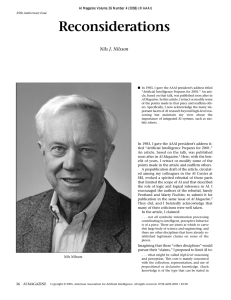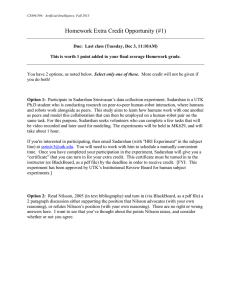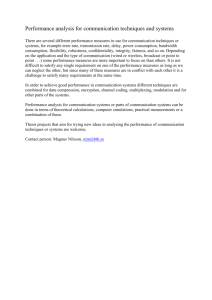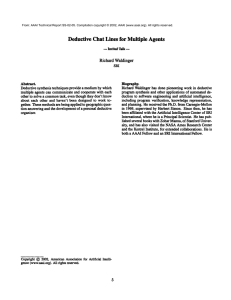LETTERS TO THE EDITOR
advertisement
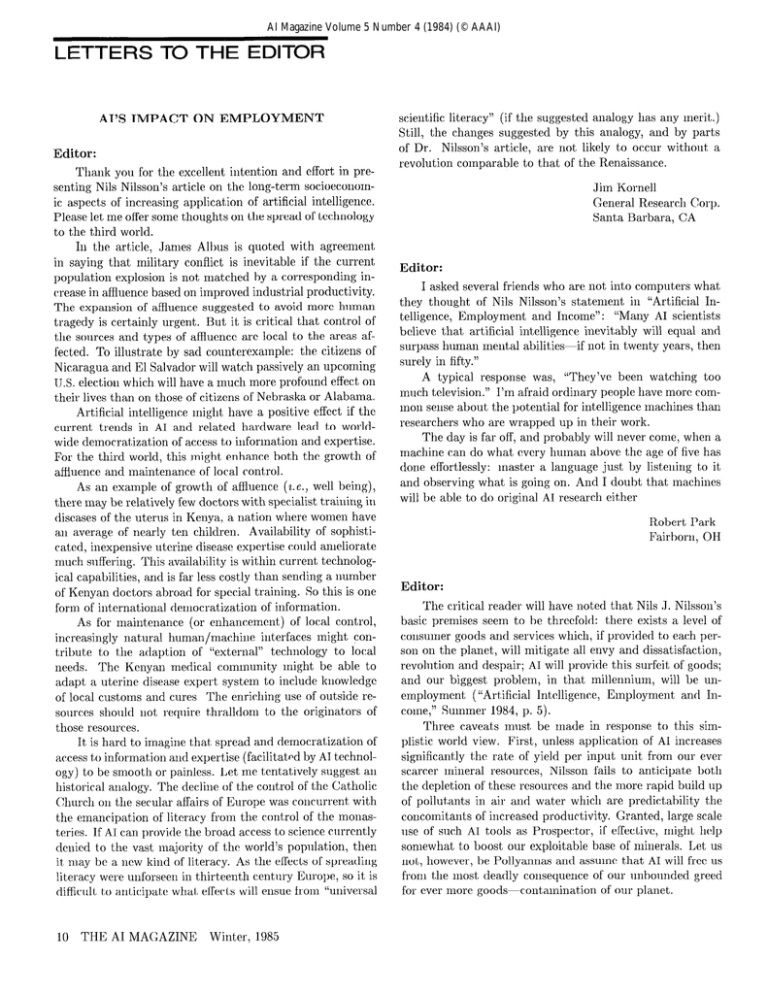
AI Magazine Volume 5 Number 4 (1984) (© AAAI) LETTERS AI’S TO THE IMPACT ON EDITOR EMPLOYMENT Editor: Thank you for the excellent intention and effort in presenting Nils Nilsson’s article on the long-term socioeconomic aspects of increasing application of artificial intelligence. Please let me offer some thoughts on the spread of technology to the third world. In the article, James Albus is quoted with agreement in saying that military conflict is inevitable if the current population explosion is not matched by a corresponding increase in affluence based on improved industrial productivity. The expansion of affluence suggested to avoid more human tragedy is certainly urgent. But it is critical that control of the sources and types of affluence are local to the areas affected. To illustrate by sad counterexample: the citizens of Nicaragua and El Salvador will watch passively an upcoming 1J.S. election which will have a much more profound effect, on their lives than on those of citizens of Nebraska or Alabama. Artificial intelligence might have a positive effect if the current trends in AI and related hardware lead to worldwide democrat,izat,ion of access to information and expertise. For the third world, this might enhance both the growth of affluence and maintenance of local control. As an example of growth of affluence (z. e., well being), there may be relatively few doctors with specialist training in diseases of the uterus in Kenya, a nation where women have an average of nearly ten children. Availability of sophisticated, inexpensive uterine disease expertise could ameliorate much suffering. This availability is within current technological capabilities, and is far less costly than sending a number of Kenyan doctors abroad for special training. So this is one form of international democratization of information. As for maintenance (or enhancement) of local control, increasingly nat,ural human/machine interfaces might contribute to the adaption of “external” technology to local needs. The Kcnyan medical community might be able to adapt a uterine disease expert system to include kuowledge of local customs and cures The enriching use of outside resources should uot require t,hralldom to the originators of those resources. It, is hard to imagine that, spread and democratization of access t,o information and expertise (facilitated by AI technology) to be smooth or painless. Let me tentatively suggest au historical analogy. The decline of the control of the Catholic Church ou the secular affairs of Europe was concurrent, with the emancipation of literacy from the control of the monasteries. If AI can provide the broad access to science currently dcnicd to the vast majority of the world’s population, then it may be a new kind of literacy. As the effects of spreading literacy were unforseen in thirteenth century Europe, so it is difficult t,o anticipate what, effects will ensue from “universal 10 THE AI MAGAZINE Winter, 1985 scientific literacy” (if the suggested analogy has any merit.) Still, the changes suggested by this analogy, and by parts of Dr. Nilsson’s article, are not likely to occur without a revolution comparable to that of the Renaissance. Jim Kornell General Research Corp. Santa Barbara, CA Editor: I asked several friends who are not into computers what they thought of Nils Nilsson’s statement in “Artificial Intelligence, Employment and Income”: “Many AI scientists bclicvc that artificial intelligence inevitably will equal and surpass human mental abilities-if not in twenty years, then surely in fifty.” A typical response was, “They’ve been watching too much television.” I’m afraid ordinary people have more common sense about the potential for intelligence machines than researchers who are wrapped up in their work. The day is far off, and probably will never come, when a machine can do what cvcry human above the age of five has done effortlessly: master a language just by listeuing t,o it and observing what is going on. And I doubt that machines will be able to do original AI research either Robert Park Fairboru, OH Editor: The critical reader will have noted that Nils J. Nilsson’s basic premises seem to be threefold: there exists a level of consumer goods and services which, if provided to each person on the planet, will mitigate all envy and dissatisfaction, revolution and despair; AI will provide this surfeit of goods; and our biggest problem, in that millennium, will be unemployment (“Art,ificial Intelligence, Employment and Income,” Summer 1984, p. 5). Three caveats must, be made in response to this simplistic world view. First, unless application of AI increases significantly the rate of yield per input unit from our ever scarcer mineral resources, Nilsson fails to anticipate both the depletion of these resources and the more rapid build up of pollut,ants in air and water which are predictability the concomitants of increased productivity. Granted, large scale use of such AI tools as Prospector, if effective, rnight help somewhat to boost our exploitable base of minerals. Let us not, however, be Pollyannas and assume that AI will free us from the most deadly consequence of our unbounded greed for ever more goods-contamination of our planet. Second, it is difficult to see how the lesser developed countries (LDC) will be benefitted by AI if it is not delivered to them in the form of capital and technological know-how. And, despite ever increasing productivity, “spill-over” from the developed courltries has not seemed to lessen appreciably in the last, one hundred years the poverty, despair, and constant revolution which Nilsson rails about. In matter of fact, several of the LDC seem more interested in the technology of weaponry than in productivity increases. (These LDC may still be served by AI, however, since pattern recognition technology is having its quickest application in target identification.) Finally-perhaps in a lighter vein-consider for a moment this prospect of displacement of huge numbers of workers by AI technology, Pernicious effects will more likely appear not among those so fortunate as to be liberated by AI, as Nilsson seems to think, but among those doomed to continue working while surrounded by legends of the formerly employed who now spend their time in activities “more gratifying and humane” (in Nilsson’s words). Won’t those left behind to work-whether in the caring professions, sport, craft, and entertainment or in the tasks of designing, overseeing, and maintaining AI technology-display the same symptoms of surly dissatisfaction as are now seen among the unemployed. Alternatively, a cynical reader may wonder how gratifying and humane will be our leisure time activities if greater blocks of time are made available to us through AI or any other technology. Consider the predictors: Watching TV and going shopping are clearly now the ma.jor cultural activities in the TJnited States. (We now spend an average of 7 hours a day watching TV.) There is nothing wrong with this, I suppose, but let’s not expect AI to have much effect except to provide more time. In reality, articles such as Nilsson’s prime an already greasy pump, boosting the enthusiasm and esprit-de-corps of AI workers, of which I am proud to belong, but they do little to convince the public that WChave a balanced perspective. Do we really believe that the worlds most pressing needs arc for more goods with less toil? Prof. Christopher Dmigan University of South Florida Editor: It was ext,remely stimulating to see that the subject of the impact, of the developments in Artificial Intelligence was brought to the attention of a larger public by Nils Nilsson (SRI) first at t,he International Joint Conference in Karlsruhe in August 1983 and then again, more extensively, in an article in AI Megaxine. It is important, that, he, as an American, is calling attention to this problem. The reason to stress the fact that Nilsson is writing on this subject as an American comes from the conviction that our thinking about economic problems is also framed within our national background. Consequently, although I agree with many of Nilsson’s points, my perspective on them is different. The position of The Netherlands differs in several rcspects from that of the United States . And it seems to me that t,he view Nilsson is promoting is enhanced by the size and richness of his country, the United States and perhaps even more by its actual political and economic policy. Living in that country, one finds it difficult to escape the temptmation to think that the world’s interests coincide with those of the United States-an impression that is corroborated by the omnipotence of the economic-military power that the United States can impose on much of the outside world. Moreover, the United States has a rapidly growing population (10% in 1983, to a large extent due to immigration), which means that even to maintain the living standard, the production of goods, houses, and cars has to rise 10%. In addition, military spending has quite some impact. Caused by all this, or on top of all this, the United States economy is booming. Although I disagree with Nilsson’s strong hypothesis about AI technology reaching the stage of complete competition with human capabilities, I think he is right in suggesting that the consequences of this and other high technologies will cause an enormous unemployment problem and that the social-psychological impact will be huge. The main impact, will be due to the ever-increasing efficiency of our industries. First, the physical space to put all our products will simply become more difficult to find. But there will also be a psychological saturation: people have more things than time to enjoy them. When our production efficiency increases much more quickly than the resources or our needs, then the productive labor to supply all needed goods will require a decreasing number of people So there will be fewer hours of productive labor per person in the years to come. Where will this lead to? Fewer working people and a growing number of unemployed with no guaranteed income, or fewer hours to work for everybody, and less money to spend? What can be done with the surplus labor force? The need to think about, this fundamental problem is less apparent, in the IJnited States because of its booming economy, which obscures the existing trends and makes them difficult to recognize-making efforts like Nilsson’s article even more important. Nilsson stipulates several solutions to this huge problem. Although each suggestion has its rationale, so far none of them has proved to be t,he final answer. One of the first is to close the market for imports. This, however, is a shortterm solution that shifts the real problems onto other people and to a later period in time, because it does not stop the efficiency to grow nor does it enhance infinitely the need for products. It only could make sense when the closing of the frontiers happens for a short time to give the industry involved the opportunity to improve its industrial efficiency. Otherwise, it only enhances the uncompet,itivcness of one’s own industry. Another method to reduce the effects will be to slow down the pace of the technical dcvclopments and thus the speed with which people will be laid off. Can that be done and by whom? From industrial hist,ory one is inclined to THE AI MAGAZINE Winter, 1985 11 draw the conclusion that no govcrmnent, but only the economic reality can bring such things about. Of course, there are means at the disposal of the government to speed up or to slow down certain developments by subsidizing directly or indirectly by taxation and the imposition of regulations. But, like the closing of the frontiers to imports, such indirect measures are dangerous weapons because they might not only promote a slowing down of its introduction and so of the lay-off of people, but they will also mean a diminishing inclination for the industry involved to modernize and so an increased danger of a loss of competitiveness. And that might in the end result in even higher unemployment. A shorter work week is much emphasized, in particular in several European countries. Then, however, the real problems start. The increased productivity seems to make better payment feasible. If the productivity rises more than the costs of capital investments needed for this increase and the increased labor costs together, then it can be done with raising t,he price of the product. But this reasoning in only valid, when there is no competition or when all the competitors follow the same strategy. The central problem-as Nilsson also stresses-is the distribution of income. This becomes even more apparent if one refuses the alternative of a shorter week. That means a decreasing amount of working people, which leads to speculation about the right of everybody to a reasonable, basic income. But this discussion decouples work and income, one of the topics Nilsson also mentions, which in itself is a counter movement to the actions of women to find their place in the labor market. The decoupling, however, has also the effect t,hat for a lot of people the motivation to work disappears with the result that much work is done sloppily. Second, the burden of not-working but well-paid people creates a rapidly growing deficit for the government. To cope with that deficit and to prevent from going bankrupt, the government has to reduce its budget, which means in effect that it has to lay off its own ernployees and so reduce the level of service. A third problem is that a government that slowly becomes everybody’s employer becomes more and more a gigantic bureacracy and an enormous financial power. The last solution is that it is the task of the govermnent to create new types of jobs. But where does t,he government get the money to pay for them.7 It, is an illusion to think that the owners of fully automated factories will be willing to keep the governmental system going. They will leave the country for better tax paradises. How can a country prepare itself? Nilsson is suggesting a kind of social think tank. I don’t expect that these institutions have much effect on what is going on in the politicaleconomic reality and in the mind of people. Perhaps my negative attitude comes from the frequent thinking-in-vacua of such instit,utions. In any case, I am really doubtful that a single country can prepare itself for this development. In our days the economics are already so much interrelated that solutions are only possible by mutual agreement, not to say in a common effort For that reason I don’t think there can 12 THE AI MAGAZINE Winter, 1985 be any social stability inside a country without one in the world as a whole. I hope that it is clear from my remarks that I don’t think Nilsson is suggesting the appropriate solutions, however attractive they might seem to be at face value. Both Nilsson’s optimistic answer and the negative one do not take the political-economic reality seriously enough; they both describe an artificial reality. The big merit of Nilsson’s cxposC is that he draws attention to very serious facts about which our societies have to make up their minds. For it is not at all obvious that the developments-left alone-will give us a rehumanized society. The industrial development so far gives us enough to think about. Joop Schopman Centrale Interfakulteit Ri.jksuniversiteit Utrecht Heidelberglaan, 3508 TC Utrecht The Netherlands Editor: Nils Nilsson’s article, “Artificial Intelligence, Employment and Income” (Summer 1984), strikes me as another example of the sheer power of fantasy that many otherwise scientific AI researchers arc capable of when requesting funding or seeking other justification of their work. We are to believe that, there will be no real excuse for work in another 50 years of automation. Yet, after 50 years of great progress in automation since the last reduction in the average work week many more people are employed than were in the 1930s. At the same time we have seen and we will see dislocation after dislocation, personal tragedy after personal tragedy, of those displaced by automation. If all were right in the world, progress in technology need not mean misery Our economic system is not only one of justice, compassion and democracy, but also one of power, greed and authoritarianism. How many times has there been a vote at a factory whether or not to automate ? The truth that Nils Nilsson avoids is that both employment and unemployment will go on. This may be pleasant for computer scientists, but not very solacing to displaced auto workers. Technical solutions solve only technical problems. For example, the scientific miracles of the Green Revolution have not eliminated hunger and possibly may have increased it. The technology already exists to feed every person alive, yet about one-quarter of the earth’s population is mahiourished or undernourished. The problems of humankind arc social, not technical. How can a society that has destroyed the culture and economy of Polynesia and many other Pacific peoples expect that computers will bring to us a similar culture to the one we destroyed? Will a few shares of IBM stock make up for the loss of a skilled union job for a job at minimum wage? So why the fantasies of Mr Nilsson? We must recognize that, the philosophy of technical progress is a blinding and Continued on page 14 conservative one. To the well off and the powerful it is a justification of their sucess. To those less fortunate it is a false promise of a future. Such a philosophy is tempting to our profession that is intimately married to both technology and those with the economic power to fund research. Still WC must demand of ourselves and our colleagues that our work make this world a better place not only for those with economic power, but to all people. David Drager University of Pennsylvania NILSSON RESPONDS Editor: Thank you for t,he opportunity to reply to letters conccrning my article. I heartily agree with everything Mr. Iiornell says Mr. Park and his friends are entitled to their opinions about t,he ultimate limits of AI. He doesn’t say whether his conservative view stems from thinking that the technical problems are just too difficult or from some sort of vitalist outlook. In any case, I wouldn’t want to bet on either of those “barriers” holding. Of the three basic premises attributed to me by Professor Dungan, I subscribe only to a rephrased version of the second, namely that AI (and other technologies) will ult,imatcly be able to provide, without much human assistance, whatever lcvcl of goods and services we decide we ueed. Envy and dissatisfaction will no doubt remain- -maybe even increase ~~ with increasing goods and services. As for unemployment, I don’t see it, as a problem in it,sclf, rather I see income distribution and rewarding use of time as problems. If t,hese latter could be solved, I think unemploymeut, would be welcomed. I agree that resource depletion and enviromnental contamination by a world population whose growth is out of control are problems fully as serious as the ones I mentioned. As regards leisure time, we might not all choose activities that everyone would regard as fulfilling. Some might choose to watch TV, some might choose to writ,e (and reply to) letters to the editor. In any case, I would want to be careful about telling someone how s/he ought to use time. Lastly, I ccrtainly do not believe that the world’s most pressing need is for more goods with less toil; but I wasn’t, writing an article about the world’s most pressing needs. I was simply trying to point out that developments in AI will lead to unernployment and that, that, wasn’t necessarily bad iu itself. Although Professor Schopman says that he doesn’t t,hink I am “suggesting the appropriate solutions.” he seems not to suggest any. Mr. Drager and I might uot be as far apart as he seems to think; I’d like to talk to him more about all of thisprovided hc can first bring himself to believe that my “failtasy” has nothing whatsocvcr to do with “reqnestiug funding” or “seeking other justification” of AI work. Much of his argunlent, seems to be with those who arc so t,aken by 14 THE AI MAGAZINE Winter, 1985 technology that they fail to see that many improvements in the human condition can be achieved only by changes in behavior and attitude. But, let’s be content to put technology in its proper perspective without limiting in any way its potential to help us. He says that “if all wcrc right in the world, progress in technology need not mean misery.” Tcchnology need not mean misery in any case-nor need it mean happiness. I’m only claiming that it is likely to mean mlemployment. Does Drager really think that factory workers would vote not to automate if the choices were expanded to include: (a) automate and lose your dull job and your income, (b) don’t automate and keep your dull job and your income, and (c) automate and use the increased productivity to provide an income decoupled from toil and use the increased leisure time for more humanly rewarding activities? Limiting the choices to (a) and (b) result,s in a rigged election, which workers ought not to tolerate! Technologists can be credited (or blamed) for ouly half of options (a) and (c); all of us must work together to create the nontechnical, the socioeconomic, half of option (c). Surely we can be allowed to hope that the self-serving uses of technology by the rich and powerful can be mitigated without, abolishing technology and denying it also t,o the rest of us. Nils J. Nilsson Senior Staff Scientist, SR.1International A SPLIT CONFERENCE? Editor: Like most participants at this summer’s AAAI convention, I enjoyed myself and felt my time was very well spent; I especially liked the wide mix of participauts. Accordingly, I was dismayed at the occasional suggestion that our group be split, with “research” and “applications” going t,heir separat,e ways. This strikes me as a mistake in a discipline as young and promising as AI. In any case, I’ve written a short report on t,he convention, but tried to do so by harking back to a fictitious convention in the 17th century~this in the hope of gaining perspective on what’s going on now in AI I hope that you’ll find t,he report suitable for AI Magazine. Thanks for your consideration. Marty Kalin De Paul Universit,y Chicago, IL Report From The Annual (AAAI?) Convention: Time: August, 5-10, 1632 Place: Florence Occasion: Annual Meeting of the Copernicus Association At times, the convention seemed to generate more heat than light. In attendance were Galileo himself, representatives from the Medicis, a few staff from the Tuscan ambassador, hucksters, military officers, merchants, astrologers, inquisitors, astronomers of every stripe, gate-crashers, sailors, philosophers, jesters, and a few scribes Politics almost drowned out the usual talk about sunspots, newly discovered stars, the role of mathematics in physics, commercial and military applications of the telescope, and so forth. At issue politically was whether the Association should be split into separate groups, or even disbanded altogether; the membership has divided itself into two fuzzy sets, and each has pinned a derogatory label on the other The “gazers,” as opposed to the “grubbers,” are a theoretical bunch, some of whom expressed regret that the telescope had been invented in the first place “Sure, it’s opened some new areas of research,” complained one famous gazer, “but most of the people here don’t understand that it’s only a tool. Just because some uppity student discovers a new star doesn’t make him a mathematical physicist Of course, the students aren’t as bad as all those former alchemists and theologians trying to pass themselves off as physicists.” He scowled extra hard for my benefit, I felt; then he went on, more heated than before: “Will you look at how the merchants and soldiers fawn over those applied types! Do you think they care about developing a theory to combat all that Ptolcmaic nonsense? No, it’s all quick fame and fortune by showing off your pyrotechnics Mark my word: the military and commercial people will be sorely disappointed in the end, and withdraw the funds from all of us. I see us sinking back into the dark ages! Ah, for the days when you had to please only an aristocratic patron, some Medici or other.” He paused to shake his head sadly, before continuing: “Maybe the Aristotelians were right after all-let’s keep theorza absolutely distinct from techne. Let Tycho’s disciples do the empirical work, and let us get back to the pure thinking ” The “grubbers,” too, seemed uneasy with the convention, but also pleased with all the attention they were getting Many were showing off improvements to the new technology, or suggesting applications. Wherever they went, a crowd of merchant and military types was sure to follow Nonetheless, they had their own axes to grind: “Look,” said one of the grubbers, as he put his arm around my shoulder, “all we hear are papers about, mountains on the moon, new satellites around Jupiter, the role of mathematics in astronomy, and the rest of it And these guys call it science! I haven’t heard two papers that fit together, much less say anything useful. You’d think the gazers own the telescope, by Jove. Where do they get off saying we shouldn’t exploit its possibilities?” Before I could answer, he started again: “Now don’t get me wrong-Galileo’s a great guy, and I wish him well in Rome But some of his supporters have their noses in the air even when they’re not gazing piously at the heavens ” He paused for a quick breath, and continued as if ant,icipating my question: “Yeah, we take money from merchants, princes, whoever. Who do you think is going to pay for better lenses so the so-called scientists can carry on with their silly speculations?” I heard point and counterpoint throughout the convention, even after Galileo spoke. In the keynote address, he tried to reconcile the factions, but without much success. He remiuded the attendees that battle against the Aristotelians was far from over, and called for unity in trying to free physics from the old philosophy: “Physics is really a brand-new discipline, and so not, yet a science; we haven’t begun to uncover the laws that extend from the earth throughout the heavens. But we’re moviug in the right direction, though the steps seem too small and slow to the impatient. What we need right now is a unity. The more popular the telescope, the more proficient its users-the better for all of us, both fledgling scientists and technicians!” Neither side applauded with enthusiasm, as each took Galileo to be favoring the other. Only the papal astronomers seemed happy. As one confided to me over wine: “Why all the fuss about the telescope? It’s of no use iu science-we already know, from ancient authority, the number and position of all the planets. And these merchants, who are they kidding? I haven’t seen one tell his sea captains to stop navigating by t,hr old chart,s ” When asked about rumors that Galileo was about to be summoned to Rome, he smiled reasurriugly: “Oh, WC might call him in for a scare; you know, just give him a tour of the facilities. After I report about this convention, though, nobody in the Inquisition will he too worried.” Editor: business meeting in Austin on g/9/84, a was the incredible growt,h in numbcrs at AAAI-84. Over 3,000 attended and another 1,000 were turned away. TJCLA can accommodate over 5,000 people for IJCAI-85, but it is likely that even more t,han t,hat will journey to Southern California. TJnless something is done differently, AAAI-86 will have to be in Las Vegas or the Anaheim Convention Center. Research papers do not draw the multitudes from government and indnst,ry. The attractive areas arc the tut,orials, the R&D exhibit, aud Technology Transfer topics. These topics have substantial value to the “new” AAAI membership (myself included), but they have little to do with the major purpose of the annual national conference: the sharing of original research and dcvcloprnent efforts by AAAI members. If the tutorials, the R&D Exhibit, and Technology Transfer topics were separated from AAAI-86, reasonable numbers of AAAI members would attend and benefit from a more focused conference. Perhaps a separate week at another time and place could bc devoted to these non-research act,ivitics. Perhaps AAAI really isn’t interested in orchest,lat,ing such a watered-down event. At the AAAI main topic of discussion John Gavin 29 Wilson Blvd Poughkeepsie, NY 12603 RESPONSE TO MCCARTHY Editor: At, the end of his Presidential Message in your Fall 1984 issue, John McCarthy, discussing t,he Turing test, states that “the ability to imitate a human must, stand up under challenge from a person advised by someone who knows how the program works.” But if t,his requirement be added many (intelligent) lmnlan beings would also flunk t,he test.. Fol THE AI MAGAZINE Winter, 1985 15 instance, I know somebody quite competent in the field of computer science who consistently failed to grasp clearly the idea of hash coding; a Turing-tester who had been “advised” of this could formulate questions which might elicit responses inappropriate to a human computer scientist. More generally, a program-p-whether in a computer or a human beingmust contain representations of knowledge and rules of manipulation of knowledge, and any gaps, defects or limitations in either of these (which always exist)-if known-can always be exploited by the Turing-tester to yield inappropriate responses. Bernard Meltzer Ispra, Italy GOING PUBLIC Editor: As a member of AAAI, I would like to set forth a proposal that may have a profound effect on the way that Artificial Intelligence is used, and researched. Presently, Artificial Intelligence, despite its recent growth rate, is the domain of a relative few. The potential for AI, however, is rather large. I am proposing that AI go public on a much larger scale than it has previously; I am proposing that college level courses be taught on either cable or public television Previously, television has covered AI as one-time installments on the science special interest series, NOVA, which was aired on the Public Broadcasting Service. There is a large and growing number of people who own microcomputers, and there is a growing number of systems which have either a 16 bit or a 32 bit bus and architecture. While 8 bits still constitutes the majority of microcomputer systems, they are slowly giving way to faster and better systems. Despite today’s systems, there are at last count, four subsets of Lisp for 8 bit systems. I believe that lessons in Lisp, Prolog, and AI should be made available to anyone who wishes to learn. While not everyone would comprehend AI, many would. The impetus from this would stimulate the sales of AI and AI-relat,ed books, add a larger pool of minds to the AI pool, and would tend to remove the cloud of mystery that presently surrounds Artificial Intelligence. I believe that tomorrow’s McCarthys, Fcigenbaunls, Winstons, etc. are out there Mr. Robert L. Salmansohn Abington, PA 19001-3412 COMPUTERLESS EXPERT SYSTEMS Editor: I read wit,h great interest Jon Doyle’s techniques and methodology paper, “Expert Systems Without Computers or. . .” in the Summer 1984 issue of the AI Magazine. An “expert” knowledge-based system feasibility study was initiated by DARPA in the late 1950s mider IJ S Army 16 THE AI MAGAZINE Winter, 1985 contractual control. However, at the time neither D&PA nor the design team identified the project in terms such as expert system or knowledge-based system. The study led to design, development, and extensive test and evaluation of such a noncomputer based expert system as Mr. Doyle now proposes. The implemented system was a success. A brief personally-recalled history, expunged for national security reasons, follows. The original study, called by its acronym MODAPS, was conducted in the late 195Os, early 1960s and indicated potential productivity and maintenance quality improvements wcrc possible using an exportable expert-knowledge-based system (not called such at the time, of course). Such a system would include maintenance strategies and techniques and data about its subject hardware and software subsystems. Design and development of A-VIS (audio-visual information system) was next undertaken to examine and test hypothesis of the study and prove feasibility through cost/performance comparison studies. This effort continued for some time, with small studies leading ultimately to a large scale test and evaluation of A-VIS in the early 196Os,under U.S. Army Test and Evaluation Command cognizance. Astonishing productivity/quality results were obtained and further work along these lines continued and does to this day (More study and test reports are available.) At the sarne time, the higherdegree of front-end analysis associated with such design led to an offshoot effort at improving the maintainability characteristics of machines through built-in maintenance and diagnostics (M&D) equipment and software. This effort was also successful and well report,ed, lending to today’s “smart” machines. It seems that the bulk of present highly publicized expert systems efforts are aimed more at, extending internal M&D outward from the machine system “core” than at dealing with human problem-solving techniques and augmenting human performance as the A-VIS and follow-on efforts have done. It is at this man-machine interface that the most difficult problems in system analysis and design occur Along this line of reasoning lies great support for Mr. Doyle’s approach. From a cost/benefit viewpoint, today’s complex systems have much higher costs for their operations and maintenance (“personnel subsystems”) than for the operational hardware/software elements of these systems. Ergo, improved syst,em cost/performance ratios can best be obtained by augmenting human performance. Projects from the 1960s effort such as A-VIS, MDS, TOPPS, TOP, PIMO, SIMMS, and other noncomputer-based concepts and systems set out to accomplish human performance improvement. Current, AI researchers should be encouraged to examine some of these projects and system reports. To avoid compromising residual security concerns, or any of my colleagues, I have omitted all rcfcrcnces to the places of this research and members of t#hemultidisciplinary team which developed the systems described. Interested AI researchers with appropriate information needs can find information about, the projectIs through DARPA and other official channels. And I, of course, will be glad to discuss flirther any underlying concepts and techniques applicable to such systems. Keith W. McCammon c/o Volt 736 Park Ave. Herndon, VA 22070 A First Rate Research laboratory. The Aerospace Corporation’s Information Sciences Research Office is engaged in basic computer science research and applications of advanced computing techniques to space systems We currently have 20 researchers, excellent computing facilities and a charter to grow We offer a mix of interesting problems, considerable freedom to choose your own course, and encouragment to publish We seek nothing less than to be one of the best computer science research laboratories Editor: 1 am a relatively new member of AAAI. My primary interests are in expert systems and the Lisp language. Your AI Magazine is a valuable source of information for those of us exploring the practical application of AI in the work environment. My particular efforts are currently directed toward studying the benefits and cost effectiveness of developing an expert system for use in the field of personnel administration in the Federal Government. While there are other sources of information to assist me in my study, the AI Magazine has been most fruitful. I would definitely encourage you to expand on the frequency of this fine publication. Quarterly issues are simply not enough. Please give us a monthly magazine. Our research program now consists of work in the following areas: Artificial Intelligence Applications. . . There are too many people needed to fly a satellite Major aspects of its control and task need to be automated What is it that all those people do, and why is it so hard to characterize their decision procedures? Program verlficatlon . . . We have one of the few serious program verification system developments in the country, and we expect to make code level verification a practical reality Loren D. Martindale Yuma, AZ 85364 Performance engineering. . . Explicit representation of performance requirements and behavior and tools to make use of information are essential automating the quantitative aspects of software design We appreciate your comments However, zt’s hard enough to produce the magazine four times a year. -Ed. Program synthesis. . For some classes of programs, it should be possible to synthesize them directly from specifications and examples Let the computer figure out the representations and applicable algorithms A?!!!= Automated VLSI synthesis. We’re trying to design very low power circuits, reduce the design time and ensure correctness of large custom circuits Tools to support these activities are crucial Now in our secondyear supplying knowledge-based e)cpertsystems to thefinancial servicescommunity. Dr. Fred L. Luconi President Dr. Norton R. Greenfeld Vice President-Software Engineering Richard Spacecraft computer architecture concepts. Reasonable sized computers arejust now going into satellites Combined with the availability of customized production of VLSI circuits, there’s a wide open field now for choosing what functions to put on board the satellite and how to carry them out I You should have a Ph D and have demonstrated ability to carry out research If these topics interest you and you are capable of leading high quality research, please send your resume to Dr Stephen Cracker, Director of the Information Sciences Research Office Responses from principals only, please I. Karash The Aerospace Corporation Vice President-Product Development Kenneth I? Morse Vice President-Market Development Dr. William ~ A. Woods Dept. 00568 P.O. Box 92957 Los Angeles, CA 90009 Chiefscientist Applied Expert Systems, Inc. Five Cambridge Center Cambridge, MA 02142 (617) 492- 7322 .. An Affirmative Action Employer U 5 Citizenship Required b n

